On March 15th, the new version of the Scaled Agile Framework was launched globally, now updated to version 6.0.
This first blog post is part of a series of articles where the team at We Are Movement will, during the coming weeks, collectively dive deeper into selected portions of the updated framework. In each new blog, we will share pragmatic advice, tips for techniques, and tools for using the ideas embedded in the latest version of the framework thoughtfully and responsibly.
SAFe 6.0 – The Updated Big Picture
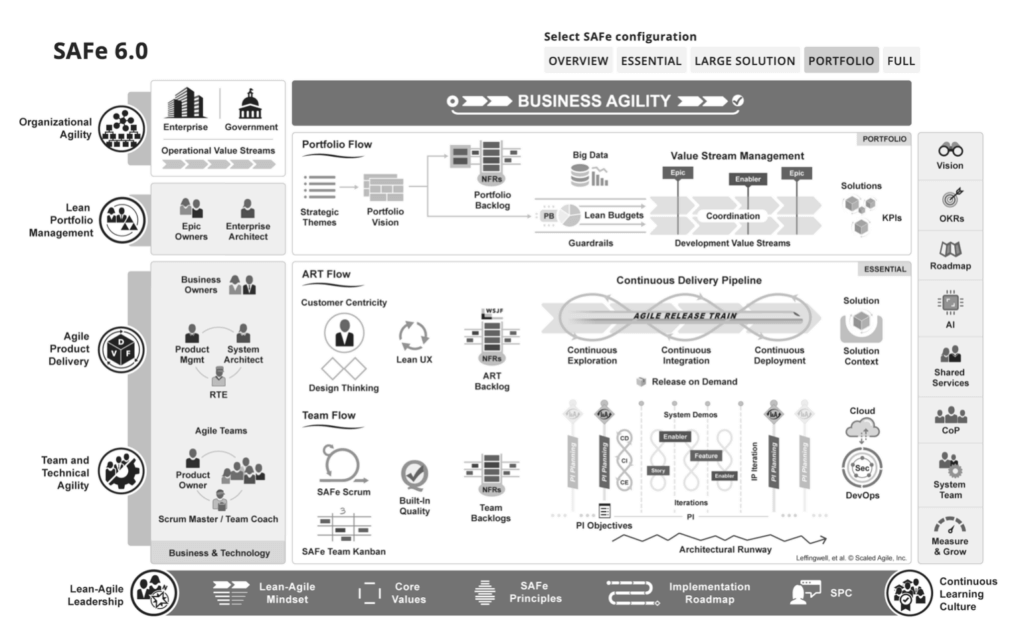
The new version is officially released as of March 15th and you can as usual find it online here.
Why a new version of the framework?
It is actually quite hard maintaining a framework and keeping it up to date in the fast-moving world of business and technology in 2023 🙂
Each successive version always builds on learning and analysis of what Lean & Agile at Scale practitioners are doing in the field. And each year, we see new learnings, new ideas, and new practices that emerge from using the modern Lean & Agile principles, techniques, and methods, and the work then is making sure that the condensed learnings reflect in the framework moving forward.
Since version 5.0 launched in 2020, the central theme has been that we see the “shift to flow” as a massive global theme. As a result, we have globally seen teams, ARTs, and Value Streams focusing even more on learning faster by decoupling, decentralizing, and concentrating on visualizing and managing the end-to-end flow of value.
The second broad theme has been that the overarching “Business Agility” focus in version 5.0 has become more present in work. We are now more and more traditional (non-IT/RnD) business functions choosing to use ideas from the world of Lean, Agile, and SAFe to enable them to “move at the speed of the Agile Product Development.”
In this article, I will focus on what I think are the four most relevant and interesting updates in SAFe 6.0:
- Accelerating Value Flow – SAFe 6.0 is “The Flow Release”
- Empowering Agile Teams and clarifying responsibilities
- Stronger Lean & Agile foundations
- More guidance for Agile Business Functions – using the ideas in SAFe beyond IT & RnD
Accelerating Value Flow – SAFe 6.0 is “The Flow Release”
When I first encountered the SAFe framework over a decade ago, I thought, “oh, great, a flow framework!”. However, at that time (.. pre-version 3.0), that was more my observation on the consequences of applying the principles and ideas in the framework than the concrete guidance and suggested methods in the early version that were heavily leaning on Scrum or variations thereof.
Now with the latest version, the guidance and methods are clear; if you don’t manage the flow, it will manage you. And many articles, practices, and methods have been clarified and updated to reflect this intent.
So, in the new version, you will find that we have built upon the work of Donald Reinertsen and the clarity found in his work on Product Development Flow and re-written Principle #6. The principle is now called “Make Value Flow without Interruptions” and is now entirely focused on the eight properties of flow that help improve the flow of value end-to-end.
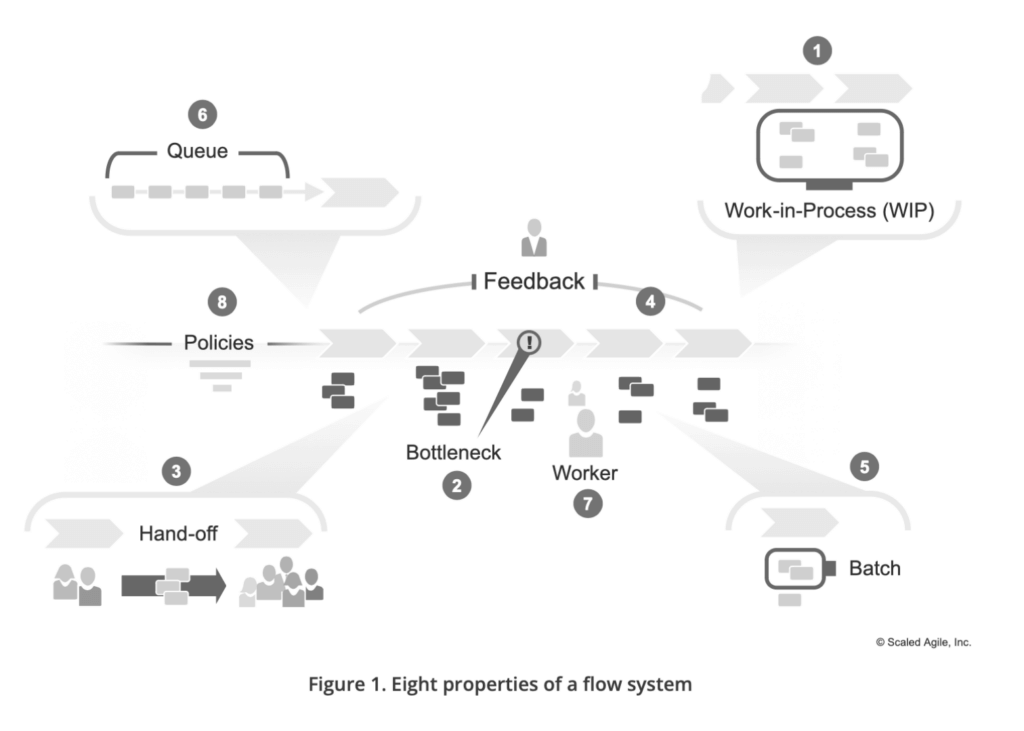
- Work In Process: In any system that aims to deliver value, there will always be some work in process. This is necessary for the flow of value to occur.
- Bottlenecks: However, in every flow system, there will also be one or more bottlenecks that limit the flow of value through the entire system.
- Handoffs: Since different individuals and teams have different skills and responsibilities, handoffs are necessary for any material flow system. Each person or team is critical in moving a work item through the system.
- Feedback: Customer and stakeholder feedback is essential to ensure efficient and effective outcomes. Ideally, feedback should occur throughout the entire process.
- Batch: Since all systems have a finite capacity, work is done in batches designed to be as efficient as possible. Prioritizing mechanisms are used to sequence work for the best value.
- Queue: The process begins with work items that need to be done. Prioritizing mechanisms are used to sequence the work for the best value.
- Worker: People are critical in moving work items from one state to another.
- Policies: These are integral to the flow of value. Local policies may determine how a work item moves from step to step within a team, or global policies govern how work is performed within the company.
It also has eight new “flow accelerators” that can speed up the flow of value, and these also have a corresponding article showing suggestions for how to apply them in the Portfolio, in a Large Solution, at the ART, and for an Agile Team.
Empowering Agile Teams and clarifying responsibilities
Historically, a not-so-uncommon mis-interpretation of the framework has been that “all teams that build a solution together have to use exactly the same methods.” However, this has never been the intent or guidance in the framework. Instead, the goal has been and still is that within the frame that Lean Portfolio Management, the shared PI cadence, and the joint alignment and intent that the PI-objectives create, the Agile teams can mix and match different flow- and pull-based methods to align, build, integrate, validate and deliver value together at extreme speed if required.
With the new version, the articles describing the suggested approach for how an Agile Team works and collaborates with other teams are much more nuanced and clear on the intent; they are empowered to choose, mix and match and evolve the way of working that they use in context. In addition, the guidance now has more options and examples for how to use more pure flow-based methods (SAFe Team Kanban), more cadence-based approaches (SAFe Scrum), or variations thereof as a team.
Also, with previous versions, the articles describing different roles in the framework have had varying quality/level of detail, especially when it comes to the questions of responsibilities for the roles, sometimes just having long (..and quite hard to read) bullet lists of suggestions.
With the new version, all role articles have received the same simplification and overview with a much more helpful summary in the form of a “Responsibility Wheel”:
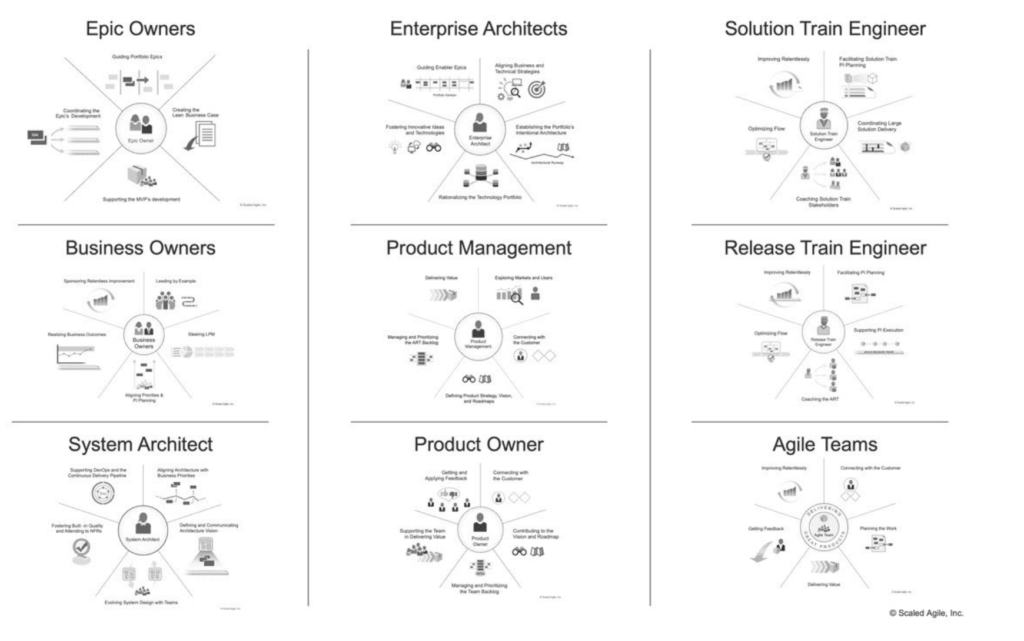
Stronger Lean & Agile foundations
The framework stands on the learnings that are embedded in the Agile Manifesto. The added nuance for building bigger solutions that SAFe has added was the integration of Lean Thinking and the end-to-end pull-based approach embedded in that; up until the new version, Lean Thinking has been metaphorically represented in SAFe with the “SAFe House Of Lean,” a powerful but somewhat complex model and visual metaphor.
To further clarify and simplify the thinking behind the principles and practices, the new 6.0 version is retiring the House metaphor and replacing it with the much simpler and more crisp “Lean Thinking” model. This properly focuses on the systemic pull/flow part, which was the core of what Lean Thinking added to the ideas in the Agile Manifesto:
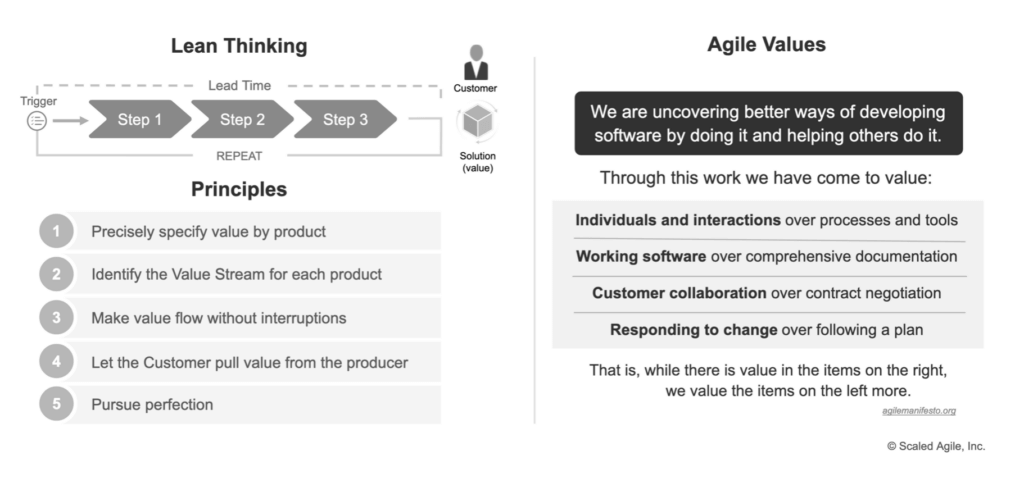
As a follow-up, a few rewrites also happened across the Core Values, Principles, and Competencies as a few of the nuances in the Lean House now needed to be adequately represented in the framework:
- SAFe’s Core Values have been updated to include Respect for People, Relentless Improvement, Alignment, and Transparency.
- Respect for People is a fundamental human need, and treating people respectfully encourages them to learn, grow, and contribute to business and customer outcomes.
- Making value flow without interruptions is the new SAFe Principle #6 related to Value Stream Management (VSM).
- Innovation is part of the Continuous Learning Culture competency, which has been added to the SAFe foundation and will be further developed in future releases.
- Relentless improvement has always been a core tenet of Lean, and it has been added as a SAFe core value because striving for perfection leads to continuous improvement of products, services, and processes.
- The SAFe Core Values were further revised to avoid redundancy with other concepts, such as Built-in Quality which is now included as a dimension of the Team and Technical Agility core competency.
More guidance for Agile Business Functions – using the ideas in SAFe beyond IT & RnD
When shifting into a Lean-Agile paradigm for creating and delivering systems and solutions, we consistently see employees and teams beyond the domain of building solutions that need to learn how to apply Lean-Agile principles to their work, such as optimizing flow, working with smaller batches, prioritizing quality, focusing on value, and using systems thinking.
The updated Business and Technology article now discusses five business and technology patterns that can support this shift based on examples seen in the field. These include:
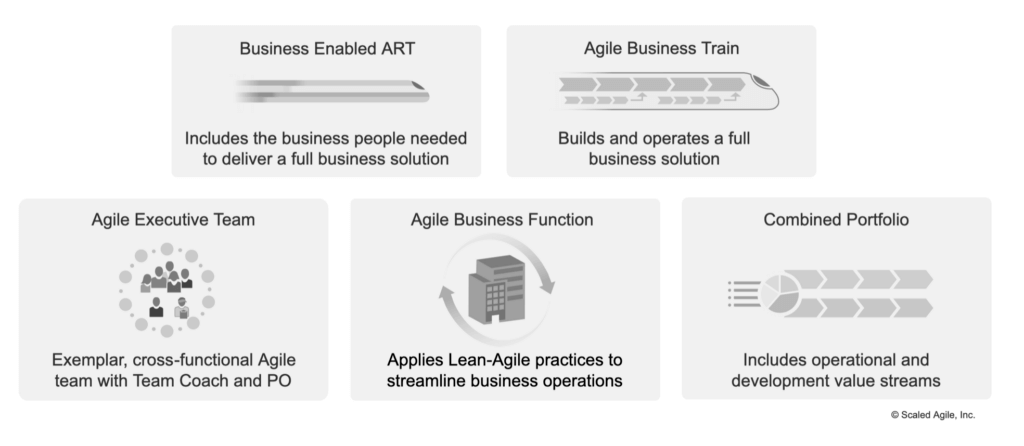
- Implementing business-enabled Agile Release Trains (ARTs)
- Launching business trains
- Creating an Agile executive team
- Applying SAFe to other business functions,
- Integrating development and operational value streams within the same portfolio.
Next steps …
In the upcoming weeks, the We Are Movement team will share additional blogs, articles, and analysis on how the new framework can be used and pragmatically applied in context, so keep watching this space and our blog! More is coming 🙂


